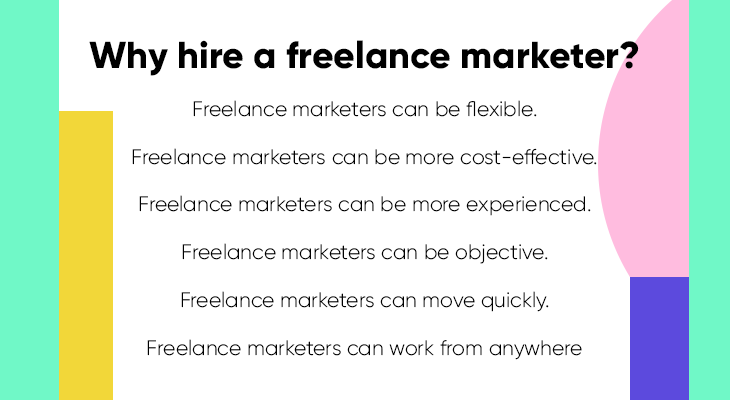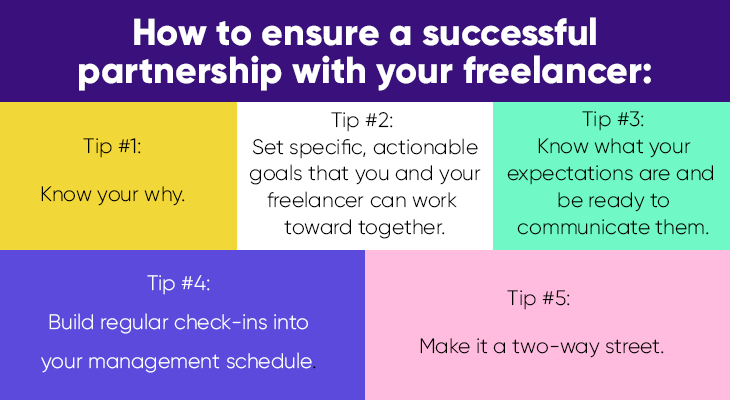The COVID-19 crisis has brought new challenges to businesses and professionals around the world. Businesses have been forced to tighten budgets, layoff full-time employees, and hunker down until the situation looks brighter again. Former employees and team members have had to deal with the stresses of sudden job and income loss, hiring freezes, and a general lack of job security as they work to keep their jobs or reenter the workforce.
As questions remain over how much longer the world will continue to be impacted by the coronavirus, more people are turning to freelancing as a way to secure income and partner with businesses that, after being forced to reduce headcount and slash budgets, are in urgent need of help from experts.
According to a recent report from Freelancer shared by CNBC, “freelance job openings increased over 25% during the April to June quarter of 2020 — compared to the first three months of the year.” The report also found that, “freelance job postings rose 41% to 605,000 in the second quarter of 2020 compared to the same period in 2019.”
The gig economy was already growing quickly before COVID-19 hit, and now it’s growing even faster.
With more talented individuals available for hire than ever before, it may be a good time to lock down some freelancers to help you achieve the marketing milestones and goals you need to hit before the end of the year.
This guide will give you the best tips, processes, and resources you need to hire and manage freelancers for your business in 2020.
Why Hire a Marketing Freelancer?

If you’re like a lot of companies right now, you may be actively tightening your belt to weather the storm brought on by COVID-19. If you are in this position, you might be asking yourself, “why hire a freelancer now?”
Here are some advantages to hiring a freelance marketer, even if you think the time might not feel right—and especially if the timing doesn’t feel right:
Freelance marketers can be flexible. One of the best things about freelancers is that they are incredibly flexible when it comes to how they engage with you. Unlike a full-time hire, you can really tweak the level of engagement you get from a freelancer depending on your needs, the type of project you need help with, and your budget. For example, you can hire a freelancer for a specific amount of time, to help complete a specific project, or for a fixed amount of money. It’s a great option when you need help but aren’t ready to bring in someone else full-time to your team.
Freelance marketers can be more cost-effective. There’s a lot of overhead that comes with hiring a full-time employee. You’re not just paying for their salary—you’re paying for health benefits, 401K, perks and amenities, stock options, onboarding, etc. It can get really expensive, really fast. When you hire a freelancer, you don’t have to worry about any of that. It’s a good option when you’re trying to save money but you still need the level of quality that you would get had you hired a full-time employee.
Freelance marketers can be more experienced. One of the benefits of working with a freelancer is that they get a lot of experience at a lot of different companies in a short amount of time. This is different from the experience your full-time employees are getting at your company. The freelancer you hire is likely working on multiple projects at once across multiple industries. They are attacking different problems, flexing their skills in different ways, and gaining more experience that they can transfer over to your company and your project.
Freelance marketers can be objective. Sometimes when you’re working on a complex problem or project, it helps to get an objective perspective. A freelance marketer can provide you with that perspective. They can understand the problem and view it as an outsider—someone who isn’t already ingrained in your organization or swayed by the same opinions or ways of thinking that your employees might be latching onto when working on the task at hand.
Freelance marketers can move quickly. Freelance marketers are incredibly nimble. A good freelancer can shift gears with ease and will not be deterred by the sudden need to pivot. This can be helpful when you’re marching toward a specific deadline or metric that you need to hit.
Freelance marketers can work from anywhere. Freelance marketers are used to working remotely, so they don’t need to be in the same physical location as you or your company to be effective. This widens the talent pool you have to choose from and can even save you money if you can hire someone who lives in a region where the cost of living is lower than other places in the U.S.
Now that you know more about the advantages of hiring a freelancer, it’s time to think more about the types of freelancers you could hire.
FREE DOWNLOAD: How to Onboard Your New Freelancer [A Quick Checklist]
8 Simple Steps to Ensure a Successful Partnership with Your Freelancer
Types of Marketing Freelancers
The type of freelance marketer you hire will depend greatly on a number of factors, such as what your existing team looks like, what projects and initiatives you’re working on, and what skills your team is currently lacking.
There are a lot of specialties and skills that can fall under the big, broad umbrella of freelance marketing. There are copywriters, growth marketers, product marketers, demand gen marketers, designers, social media experts, PR professionals, account-based marketers, email marketers, app store optimizers, paid media experts/media buyers, SEO specialists, storytellers, project managers, executive-level marketers, and everything in between.
If you need help uncovering gaps and deciding how a freelancer could help you, take a look at the following resources—they offer tips and frameworks that will help you think more about what the marketing organization should look like within your company:
- How to Structure a Kick-Ass Marketing Team for Any Company from HubSpot
- How to Structure Modern Marketing Departments For Success from CoSchedule
- The Changing Structure of Marketing Departments in the Age of Disruption from Simple
It’s helpful to know what kinds of freelancer marketers are out there, but how do you know when you should actually look for and engage with someone? We’ll dig into the answer to this question in the next section.
When Should You Hire a Marketing Freelancer?
You should consider starting the process of finding and hiring a freelancer if some or all of the following are true:
- Your team doesn’t possess the skills needed to complete a project.
- You can’t justify pulling your existing team members off of what they are working on.
- You need something done quickly and with little to no hand-holding.
- You want someone who has a lot of experience doing what you’re trying to do.
- You aren’t ready to hire full-time but you need immediate help ramping.
- You want to test the waters by adding a specific skill set to your team.
- You know you’ll only need an extra set of hands for a limited amount of time.
- Your team is maxed out.

If a freelancer can help solve any of the issues above, it’s worth going through the process to find one. Ask any seasoned executive or startup entrepreneur, “what is the biggest thing stopping you from growing or achieving your goals faster right now?,” and they’ll tell you it always comes down to people. So don’t let lack of people resources stop you from taking your company to the next level and remember that more people doesn’t have to mean more full-time employees—more people can mean more freelancers.
Understanding Your Needs and Goals
When you’re finally in a place where you want to hire a freelance marketer to help you complete a project or fill a gap, it’s important to step back and spend time really understanding what your needs and goals are.
The success of your engagement with any freelancer will ultimately come down to how clear you are able to be about your needs, goals, and expectations.
Here are a handful of tips that can help you ensure you’re prepared for a successful partnership with one or more freelancers:

Tip #1: Know your why. Before engaging with your freelancer, spend time thinking about and documenting your why. Think about the reason why you need the type of freelancer you need and what the engagement is going to allow you to do.
Tip #2: Set specific, actionable goals that you and your freelancer can work toward together. Come to the engagement ready to share actionable goals that you want your freelancer to keep in mind as they work. Your goals could be project-based, time-based, or results-based.
Tip #3: Know what your expectations are and be ready to communicate them. Write down a list of expectations and be ready to walk through them together when you first meet with your freelancer. Make sure your freelancer understands and agrees to the expectations, and don’t be afraid to reinforce them throughout the length of the engagement.
Tip #4: Build regular check-ins into your management schedule. Create milestones and opportunities for regular pulse checks throughout the engagement with your freelancer. Make it clear when progress is being made and when progress isn’t. Celebrate wins and be a resource when they need help.
Tip #5: Make it a two-way street. Involve your freelancer in goal-setting, process builds, and conversations as much and as early as possible. Give them an opportunity to provide feedback and be willing to listen to and act on what they say.
Writing Your Job Description
Writing a good job description is another crucial step in the process of finding the right freelancer for your business. Your job description allows you to take all of the information you thought about in the last section in terms of goals and expectations and package it in a way that your prospective freelancers can quickly and easily understand.
Every job description is a little different and depends on the role and company its written for, but in general, your job description should include information about:
- Your company
- Your culture
- A title and summary of the role or project
- Specific responsibilities
- How you’ll track success
- Who you’re looking for / who will do well in the role
For help writing effective job descriptions, spend time reading through this helpful guide from Fast Company.
How to Find Marketing Freelancers
These days it’s relatively easy to find marketing freelancers—the trick is finding the right one for your project. After you have a good idea of what your needs, goals, and expectations are and you have your role clearly outlined, you’re in a good place to start searching for a freelance marketer. When you’re ready to start looking, you have a few options:
Option 1: Ask People You Know
One of the fastest ways to find a freelancer is to simply ask people you know for referrals. Your employees, partners, and professional network are likely connected to one or more freelancers that could match what you’re looking for. Take the opportunity to ask for recommendations from people who have worked with certain freelancers in the past and had good experiences.
Option 2: Promote the Opportunity on Social
Use LinkedIn and other social media sites to promote the opportunity. Share information about the role, the project, the time frame, your expectations, and more about who you’re looking for. To get the most out of this option, you should share with your personal connections and on your company page. Don’t be afraid to promote the opportunity more than once. You can also ask your employees, colleagues, and partners to post about the opportunity on their personal profiles.
Option 3: Tap into an Established Network
One of the best ways to find reliable marketing freelance talent is to tap into an existing community of pre-vetted freelancers. There are a lot of services and sites you can use, including GrowTal, which can save you a lot of time and headaches when it comes to finding, matching with, and onboarding a freelancer.
With GrowTal, for example, all you have to do is fill out a 2-minute questionnaire about your project. From there, the team at GrowTal will evaluate your needs and match you to a freelancer who has already been pre-vetted and prepped to take on a project like yours. The average time it takes to handpick and match you with a freelancer is under 48 hours.
Tapping into existing networks like this is a great option if you don’t have time to do the heavy lifting but you still want to find the best and most qualified person for the job.
Interviewing and Vetting Freelancers
Because there are so many freelancers out there to choose from, it’s important that you have clear processes in place when it comes time to interview and vet potential talent. Picking and onboarding the wrong freelancer for your business can be expensive. The following tips will help ensure you’re narrowing in on the right candidate.
Tips for Interviewing Freelancers
Tip #1: Ask them to talk about specific projects. Try to get a better idea of the experience they have and what kind of work they’ve done in the past by asking them to walk you through specific projects and how they went.
Tip #2: Ask them about their working style. Find out what kind of working style they prefer most. Are they OK working on their own? Do they like more engagement with full-time team members? How do they prefer to communicate and provide updates on projects?
Tip #3: Ask them about your company. Find out if they’ve done any research ahead of time to learn more about what your company does and who your customers are. The best freelancers are the ones who approach engagements in terms of a true partnership as opposed to another transaction.
Tip #4: Ask them what they need to do their best work. Don’t make it all about you and your needs. Find out what your candidate needs to feel comfortable and enabled to do their best work. It might mean working different hours than you, giving them a seat to one of your project management tools, or simply making time to check in with them once a day. Spend as much time listening during your interview as you do asking the questions.
Tips for Vetting Freelancers
Tip #1: Always ask for examples or samples. Every freelancer should be able to provide you with an example or two of the type of work you’re hiring them to do. To vet your freelancer, ask them to send you samples, a link to their portfolio or an example of recent work.
Tip #2: Find out who they’ve worked for in the past. Ask them if they can tell you who they’ve worked for in the past. You can learn a lot about a freelancer by the types of companies that hire them.
Tip #3: Talk to past clients if you can. If you know who they worked for in the past, consider talking to the person who hired them about their experience. Find out if it went well and see if they have any advice to give you when it comes to managing the freelancer.
Tip #4: Do a quick Google and social media audit. Look for any concerning information or content on Google or social media. Even if the freelancer you’re hiring is working in an anonymous or non-promoted capacity for you, they still represent your company while they are working for you. Make sure you are aligning yourself with professionals and not opening your company up to any risk or bad press down the road.
Tools for Communication & Project Management
There are a few well-known tools you can use to manage and communicate with your freelancer. Here is a short list:
- Slack or Teams: for messaging, video or audio calls, and team collaboration
- Asana, Trello, Monday, Airtable: for project updates and collaboration
- G Suite or Office 365: for file-sharing, emailing, scheduling meetings
There are literally thousands of other tools you could choose from to manage and communicate with a freelancer—use the ones that work best for you and your team.
Common Mistakes & Challenges to Overcome
No engagement ever goes perfectly, and that’s OK. The best thing you can do is be as prepared as possible. To ensure you are, take a look at these common mistakes and challenges before starting work with your freelancer:
Common Mistakes
Mistake #1: Not creating a contract. Contracts can take time and money to produce, but they are worth it. It’s the best way to set clear expectations right off the bat and ensure that everyone is on the same page about deliverables, timeline, invoicing, and payment.
Mistake #2: Not setting clear expectations. This one is big. Expectations on both sides need to be clearly outlined. Give yourself space to talk about it at the very beginning of a contract, and you’ll reduce the amount of issues that come up later.
Mistake #3: Not being ready to work with a freelancer. Don’t think that it’s all up to your freelancer to ensure a successful partnership—you need to be equally as prepared and committed. Work gets busy. Things always come up. Make sure you are carving out the amount of time your freelancer needs to keep the project moving forward.
Common Challenges
Challenge #1: Miscommunication or lack of communication. Communication is key when it comes to managing a freelancer relationship. It’s especially true when you’re working with someone in a different location or time zone than you. The best way to overcome this challenge is to over-communicate and ask your freelancer to do the same. Leave no one guessing where you are at or what’s next.
Challenge #2: Setting realistic deadlines and timelines. Set aggressive deadlines and timelines, but don’t be surprised when projects get delayed and work takes longer than expected. The best way to overcome this challenge is to give yourself a little extra buffer room when setting timelines and deadlines. It’s always better to be early or on time than to be unexpectedly late.
Challenge #3: Payments. Do what you can to pay your freelancer on time per the terms of your contract. Missed or delayed payments can wreak havoc on freelancer engagements. If you can pay early, do it. The best way to overcome this challenge is to simply keep on top of it. If it’s someone else’s job to make sure your freelancer gets paid, it’s your job to make sure that person is paying on time.
Build True Partnerships with Your Freelancers
As we’ve mentioned, the best freelancer engagements are the ones where everyone works together and is valued and treated with respect. Ensure your success by really investing in freelancer engagements and treating them like they are a true member of your team—because they are.


